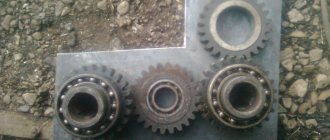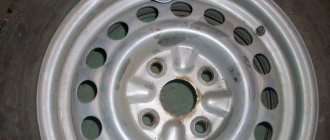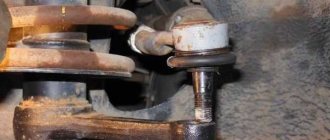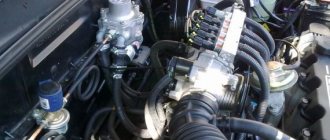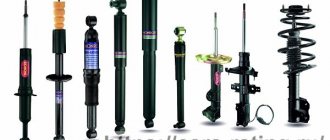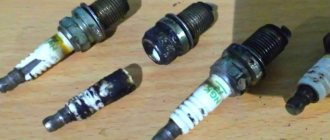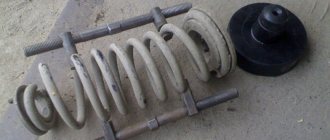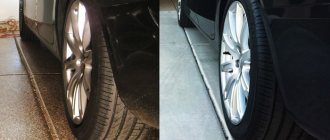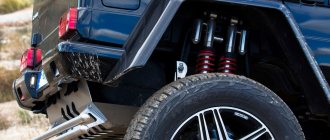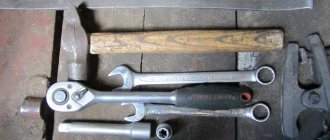What are spring spacers and why are they needed?
Spring spacers are additional units installed on the vehicle. The task of these units is to increase the ground clearance between the vehicle and the road surface, which differs from the factory parameters. The reason for installing spacers is most often the dissatisfaction of car owners with these factory parameters.
If you own a car with minimal ground clearance, then every trip outside the city can turn into trouble for you. The point here is not even in such characteristics as fuel consumption, engine power and range, but also in such characteristics as, for example, ground clearance.
In most cases, when going on a country trip, you will encounter at least one section of the road that has poor road surface. If your car is not raised enough from the road surface, you can easily damage the body or even get stuck on even small obstacles. Unfortunately, on some roads only the BMP-3 can pass at all, but increasing the gap between the lower part of the body and the road is sometimes not superfluous.
Most SUVs and crossovers are designed this way. Their main task is to confidently drive on dirt roads, damaged paved roads and in conditions where there is no pavement. This is achieved, among other things, thanks to this “elevation” of the body above the surface.
In various adverse weather conditions, such as rain, river floods, falling branches and snowfalls, the movement of a vehicle with minimal clearance may be difficult. Such cars will not be able to overcome some difficult sections of roads, even in urban conditions, where special services sometimes cannot cope with the pressure of the elements.
If you want to understand whether your car needs an increase in ground clearance, you should calculate it. Ground clearance is the minimum distance between the lowest point of the car body and the road surface. Due to the numerous protrusions and small parts at the bottom of the car, finding this very point may take some time. However, most often the lowest point is directly under the engine. When calculating ground clearance, also take into account the protection under the engine in the form of a metal or plastic skirt, evenly located under the power unit. The most unpleasant thing in this situation is that the plastic skirt that the car received as standard will not be able to fully protect the engine from breakdown, but it will also take away some distance from the road surface. We have to put up with it.
So, the purpose of spacers is to increase ground clearance. To do this, they are installed under the springs or at the place where the shock absorber and car body are attached. The installation of such spacers is most often justified when it is necessary to increase the natural ground clearance, the value of which has decreased during the operation of the vehicle. Such changes are suitable for car owners who often travel by car off-road or on poor-quality surfaces.
What is it about
Before you figure out what spacers are to increase ground clearance, you need to figure out what ground clearance is. clearance, in other words ground clearance , is the distance between the lowest point of the car body and the road.
Actually, why does a motorist need to increase the ground clearance? As already mentioned, various situations can lead to the fact that the ground clearance is reduced (damage to springs and fasteners, for example), or the factory one was not high enough. A car is, first and foremost, a means of transportation. A vehicle that sits tightly to the ground will not be able to drive without damaging the underbody. This can have a serious impact and make the car unsuitable for driving, which is why the question arises of increasing the distance to the road. Also, increasing the ground clearance is of interest to people who like to drive off-road.
So, increasing ground clearance is often done using special spacers. This is especially common in the case of subsidence of “native” springs. These spacers are spring mechanisms or additional fasteners. They cope with the task of increasing the clearance very well. Moreover, the procedure for attaching such magnifiers is the most accessible, since they themselves are not expensive - one spacer can be purchased for a price of 1000 rubles .
Air cylinders also cope just as well as spacers . It turns out even cheaper, and a “healthy” car with working springs does not suffer.
However, to decide whether such a modification is necessary, risk factors must also be taken into account. Of course, this idea has plenty of advantages, but it is not without its disadvantages - one way or another, any change in the “native” design always lies on the conscience of the motorist, and no one gives guarantees for its effectiveness. Before deciding to modify to increase ground clearance, weigh the pros and cons.
Materials for the production of spacers for springs
The body of polyurethane spacers is made of polyurethane, and the bushings are made of steel. Rubber spacers are made of high quality elastic rubber. Some inserts are made of plastic and aluminum. There are other, less popular materials, but we will not consider them.
You may also be interested in an article by our specialist, in which he talks about how to install air springs in springs.
Don’t know how to make your own air suspension? Be sure to read our expert's informative and useful article.
Ready-made kits to increase ground clearance
The types of such kits vary significantly depending on the car model. As a rule, the front struts come with kits with steel or aluminum spacers. The cost of such kits also varies significantly. The price greatly depends on the manufacturer who installs it and on the material used. The services also offer paid services for installing spacers, which is completed in a short time. The kits also vary in how the spacers are installed. The front spacers are a box with mounting holes. Rear spacers are rings with special eyes.
Most often, experienced car owners recommend purchasing sets of aluminum spacers. Such spacers will cope with their task for much longer - increasing ground clearance. However, kits made of plastic are gradually becoming more popular due to the low cost of this material.
The picture shows the contents of one of these kits.
Aluminum spacers
Such spacers are distinguished by fairly high strength indicators. Corrosion resistance and good decorative surface of the material are some of the few advantages of aluminum spacers. Such spacers can withstand heavy loads, which reduces vehicle operating costs. The high corrosion resistance of the material extends service life, expanding the range of interactions between various media, including liquids and gases with high aggressive concentrations. Those. Neither rain, nor snow, nor other weather conditions affect this part of your car. Thanks to these factors, the service life of spacers is significantly longer compared to analogues made from other materials.
Pros and cons of installing spacers
Of course, spacers increase ground clearance. Due to this, the vehicle's cross-country ability and ground clearance are increased, resulting in a reduced risk of damage to various parts of the vehicle's underbody. Both the engine and the driver himself are safer, as they will not suffer from constant shocks and jolts.
However, such modernization of a car can sometimes lead to serious disadvantages, described below:
- If you increase the ground clearance, the vehicle's center of gravity will also shift. As a result, the vehicle's road stability and controllability can be significantly reduced.
- The rigidity and reliability of the suspension design may also decrease. The width of the wheelbase changes along with the toe-in and steering angle of the wheels.
- The steering mechanism becomes more susceptible to wear of its components and parts.
- The position and performance of the shock absorbers may also change.
Disadvantages of spacers
But, of course, there is a fly in the ointment in this barrel of honey. The question “to put it or not?” would not have arisen if spacers had only advantages.
The following factors may serve as arguments for rejecting this idea:
- , which was provided by the manufacturer, shifts Because of this, some extraneous processes occur during operation, which one day may result in serious problems with the car.
- Stability and maneuverability deteriorate significantly, and control problems appear: problems with turns. This is partly due to the shift in the center of gravity.
- High percentage of incorrect alignment or camber . This leads to inevitably rapid wear of the tires on the wheels and the tires themselves, and sometimes even ensures the death of the car without wheels - it depends only on the “zeal” of the installers. More about wear – the tires will begin to wear unevenly, which often causes the thought “I’ll replace them if they’re completely damaged.” But wear continues precisely at the point of first manifestation.
- Installing spacers is a direct waiver of the warranty on shock absorbers and an agreement to be ready to replace them at any time.
- Reviews from car owners who have undergone this procedure say that after installing the enlargers, the components of the car's chassis wear out significantly .
- There is always the possibility of going overboard . With self-modification, there is a high percentage of cases when the ground clearance is increased too much, the car becomes even more unstable and uncontrollable.
Installing spacers for springs with your own hands
Installing spacers for the front suspension
First, we place a clean car on a level surface. Next, lift the car using a jack, remove the wheel, and unfasten the brake hoses and stabilizer struts. Unscrew 3 nuts on the upper support of the front strut. Next, the old bolts are knocked out of the strut and new ones are screwed in (read more about the front shock absorber struts).
The spacer is attached to new bolts, then all parts are reassembled. If the transverse strut spring prevents this, it is necessary to support it with something until it reaches the fastener hole.
Installing rear suspension spacers
In this case, it is better to install rubber spacers. Their advantages have been described above. To install these spacers, remove the sills located under the trunk lid and next to the rear doors. Move the rear seats as far forward as possible. The trim and lining in the trunk will also be superfluous, as will the lining of the side panels near the seats. After this, lift the rear wheel using a jack and proceed in the same way as with the spacers for the front suspension. Remove the wheel and disassemble the support by unscrewing the upper and lower nuts. Remove the support and replace the mounting bolts. Install the spacer and perform reverse installation. If you cannot find the way to the necessary bolts and nuts, use the vehicle's operating instructions.
conclusions
Installing spacers under the springs to increase the ground clearance of a car on our roads is sometimes very useful. And it doesn’t matter whether the spacers are aluminum or silicone universal. In any case, driving on off-road and poor-quality surfaces becomes more comfortable. And many people like the effect of the car being raised above the road. However, you should not abuse the installation of spacers and increase the ground clearance too much if you do not want to lose the driving performance of the car and reduce comfort. Good luck and easy travels!
What are car spacers
A spacer is a part that is placed under the shock-absorbing springs of a car to make the car higher. From the external video it is immediately noticeable whether the car is raised. A raised car allows you to drive in hard-to-reach places, if the terrain allows.
Young people install linings and spacers to increase the height of the car, as external tuning, for example, sticker bombing. On the street you can often see classic VAZ cars “lifted up” to the maximum possible height.
Some brands and models of cars are produced with low seating and low ground clearance. When driving out of town or around the city in winter, the vehicle's low ground clearance creates unnecessary difficulties. Cars that are too low quickly sit on their “belly” and get stuck.
But, there are also drivers who, on the contrary, lower the car to the maximum, the ground clearance becomes very small and such drivers even have to sideways drive over a speed bump.
Engine crankcase protection is installed by car owners at will. The car comes from the factory without protection. Therefore, in the technical specifications of the car, the ground clearance is indicated to the bottom of the engine crankcase, for example, 23 centimeters. If you install engine protection, the ground clearance will decrease by another couple of centimeters.
Therefore, installing spacers allows you to improve some characteristics of the machine. They are installed under the springs or where the shock absorbers and car body are attached.
What kits are there?
Depending on the make and model of cars, ready-made kits vary greatly. To increase the front part of the car, spacers containing aluminum or steel are installed on the front pillars. Front spacers are boxes with lugs with holes for bolt-on mounting. The rear spacers look like rings with special eyes.
Typically, installers at specialist service stations recommend buying aluminum spacers. Aluminum spacers last longer and maintain a given height.
But, despite the recommendations, plastic spacers are becoming more popular due to their low cost.
Ready-made kits for increasing ground clearance can be ordered in online stores. The main thing is to choose them correctly so that they fit in diameter, method of fastening and height.
What is a gearbox, for example, a rear axle gearbox? Why does a hum appear in it that stuffs up your ears?
The photo below shows a set of spacers to increase the ground clearance of an AUDI car.
Pros and cons of spacers to increase ground clearance on cars
Unfortunately, the quality of roads in many Russian cities, to put it mildly, leaves much to be desired. And while in large metropolitan areas the situation is gradually changing for the better, most regions cannot yet boast of this. As a result, even owners of domestic cars often think about the need to install spacers on a VAZ to increase ground clearance.
Such modifications will allow you to slightly raise the car body, thanks to which you can significantly reduce the risk of damaging the bumpers and sills, and also stop scraping the bottom on particularly harsh sections of the road with deep holes and ruts. At the same time, the use of spacers is also available to owners of a large number of foreign cars.
Not everyone can afford SUVs or tall crossovers, and most imported cars are not particularly well adapted to Russian road conditions, especially compared to Lada models, which already have decent ground clearance from the factory.
So if the owner of a low car has to regularly drive on roads with holes, potholes, ruts, mud, puddles and other “delights”, then in this case it is definitely worth thinking about installing special spacers. Note that kits of the latter are available for almost any type of suspension, both rear and front.
Pros and cons of spacers for increasing ground clearance
+ Pros
- Low cost
- Easy to install
- Available for a wide range of vehicles
- Can be used for sagging springs
- Minuses
- You may lose your warranty if you install it on a new car.
- Increases the center of gravity
- Increasing the load on shock absorbers and reducing their service life
- Most likely you will need to re-do the camber/alignment
One of the key objectives of increasing a car's ground clearance using spacers is to improve cross-country ability, but their use can also be useful if you often have to carry something heavy in the trunk or several people in the cabin, or perhaps both at the same time. So using spacers will help avoid severe sagging of the rear suspension.
Among the disadvantages of spacers, deterioration in handling is often cited - a raised car becomes more rolly. In general, this is the case, so after installing the latter you should choose the appropriate driving style. Also, a lot depends on the quality of the installation, so if you have doubts about your own abilities, it is better to entrust this procedure to specialists from a proven service.
What types of spacers are there?
By installation type
- Under racks
- For shock absorbers
- Under springs
According to the material of manufacture
- ABS plastic
- Polyurethane
- Rubber
- Aluminum
- Steel
Of course, spacers also differ in height - the most common sizes are 20, 30, 40 millimeters, but in some cases you can select more specific parameters. As for the materials of manufacture, the most common now are polyurethane and ABS plastic, which, unlike metal ones, are not subject to corrosion.
This material was prepared with the support of https://tema4x4.ru/ - a manufacturer of spacers for increasing vehicle clearance. The company's website offers a wide range of products, with delivery all over the world. The online consultant is ready to answer any questions you may have.
Pros and cons of spacers
We discussed the main advantages of the installations above: increasing ground clearance, protecting the car body from damage and dents, and saving time when driving over obstacles.
But, there are also disadvantages to operating a car with installed spacers. These include:
- Due to the change in body height, the center of gravity also rises, causing directional stability to also change. Everyone knows that the lower the car, the more stable it is at high speeds and when cornering. Therefore, after increasing the ground clearance, it is recommended not to drive.
- The rigidity and reliability of the machine structure may also change.
- Steering gear parts may wear out faster.
- The performance of shock absorbers may also deteriorate.
- If you use polyurethane spacers, then if the polyurethane wears out, the steel part of the spacer will wear out the seat on the car body.
Advantages of rubber gaskets
Rubber spacers withstand various negative environmental influences (acid, salts, water, etc.). The comfort and driving dynamics of the vehicle do not deteriorate. There is no corrosion of the seats where the rubber spacers are installed.
Disadvantage of rubber gaskets
- rubber can deteriorate in frost and extreme heat;
- the resource is less than that of spacers with metal.
Aluminum spacers are considered the most reliable, since although they oxidize and corrode, they last a very long time.
Spacers made of ABS plastic are protected from corrosion and serve for a long time. Its price is average, approximately 1500 rubles. No shortcomings have been identified yet.
Do you know what swap is? An engine swap is sometimes a very necessary method.
Useful recommendations for lift installations and suspension spacers:
- Do not install aluminum spacers without treating them with anti-corrosion agents.
- Do not raise the front of the car more than 2 centimeters.
- On some cars, shock absorbers are installed far from the springs. For cars of this design, it is better to install spacers under the springs themselves. This installation will protect against imbalance.
- The rear of the car can be increased to such a height that it is no higher than 3 cm of the front.
- It is not recommended to lift the clearance by more than 30 mm.
- Spacer sets must have their own bolts and nuts.
How to choose spacers to increase ground clearance
In the process of choosing spacers, you should first of all take into account the parameters that affect the efficiency, safety and durability of tuning.
- The shape is selected individually for each car. In order to achieve full compliance of the selected products with a specific car model, before purchasing you must consult with the manager, providing information not only about the car, but also about changes in the chassis, if any.
- Lifting height . On most cars, an increase in ground clearance of more than 30 mm causes wheel alignment/camber problems. It is recommended to increase the ground clearance by no more than 20 mm for the front wheels and within 30 mm for the rear suspension.
- The material plays an important role in the formation of performance qualities. To increase ground clearance, spare parts made of metal, regular rubber and polyurethane, which is a top seller, are used.
Other parameters do not actually affect the characteristics of the car and are chosen solely based on personal preferences.
How to install spacers yourself?
Installation on the front and rear suspensions is different. The installation procedure for the front suspension is as follows:
- Place the car on level ground.
- According to the rules for replacing a wheel, we lift one side of the jack in compliance with safety regulations (installation of anti-recoil devices - shoes, supports under the bottom of the car in case the jack breaks).
- We remove the wheel.
- Disconnect the brake hoses and stabilizer struts.
- Unscrew the 3 nuts on the upper support of the front strut. Then the bolts are knocked out of the rack and new ones are installed.
- A spacer is attached to the new bolts and all parts are assembled in the reverse order. During assembly, the transverse strut spring will get in the way, so you should press it until it reaches the fastener hole.
Installation of spacers on the rear suspension of a car is carried out in the following order:
- Remove the thresholds. The ones under the trunk lid and next to the rear doors.
- Move the rear seats as far forward as possible. By the way, if you suddenly plan to make built-in heated seats, we recently looked at how to do it, what types there are, what the effect is.
- Remove the trim and trim in the trunk, and the trim on the side panels next to the seats.
- Raise one rear side of the car with a jack.
- We remove the wheel.
- Unscrew the upper and lower support nuts.
- We remove the support.
- We knock out the old bolts and install new ones.
- Install the spacer and begin assembling the parts in reverse order.
What to consider when lifting a car
The ground clearance of passenger cars ranges from 14 to 21 cm. SUV cars have a ground clearance of 18 to 25 cm. Off-road cars have a ground clearance of up to 35 cm.
In addition to installing spacers, you can raise the car by installing longer springs and shock absorbers. If you change the length of the springs and shock absorbers of a new car, the warranty will be void. In this case, it will no longer be possible to repair the car for free.
In general, since the center of gravity changes after increasing the ground clearance due to the use of non-original factory parts, it is a case that the warranty on the car ceases to be valid.
Conclusion
For passenger cars with low ground clearance, installing spacers to increase ground clearance is a beneficial solution. The main thing is to choose correctly, install correctly and operate correctly.
It is beneficial to install aluminum, rubber, silicone spacers. They just have different lifespans and affect driving differently. Aluminum ones are more durable, rubber and silicone ones are universally soft and do not affect control, but wear out faster.
In order not to significantly change the driving characteristics of the car, you should not raise the car more than 3 cm.
Types of spacers to increase ground clearance
To determine for yourself which spacers are best to install to increase ground clearance, you need to study the features of each of the available types.
- Aluminum products have high strength indicators. They can withstand high loads and are not subject to corrosion, which allows them to be used in any climatic conditions without fear. The disadvantage is the high price.
- Polyurethane spacers are not inferior to aluminum in terms of protection and reliability, but at the same time they have greater elasticity, tear resistance and an affordable cost. High plasticity allows them to deform under strong impacts and significant loads, and then return to their original state.
- Rubber parts have the elasticity of polyurethane analogues, but are significantly inferior to them in strength and reliability. Their rupture can occur under any relatively high load. The advantage can be called the price, but taking into account the durability of the material, this is a dubious advantage.
